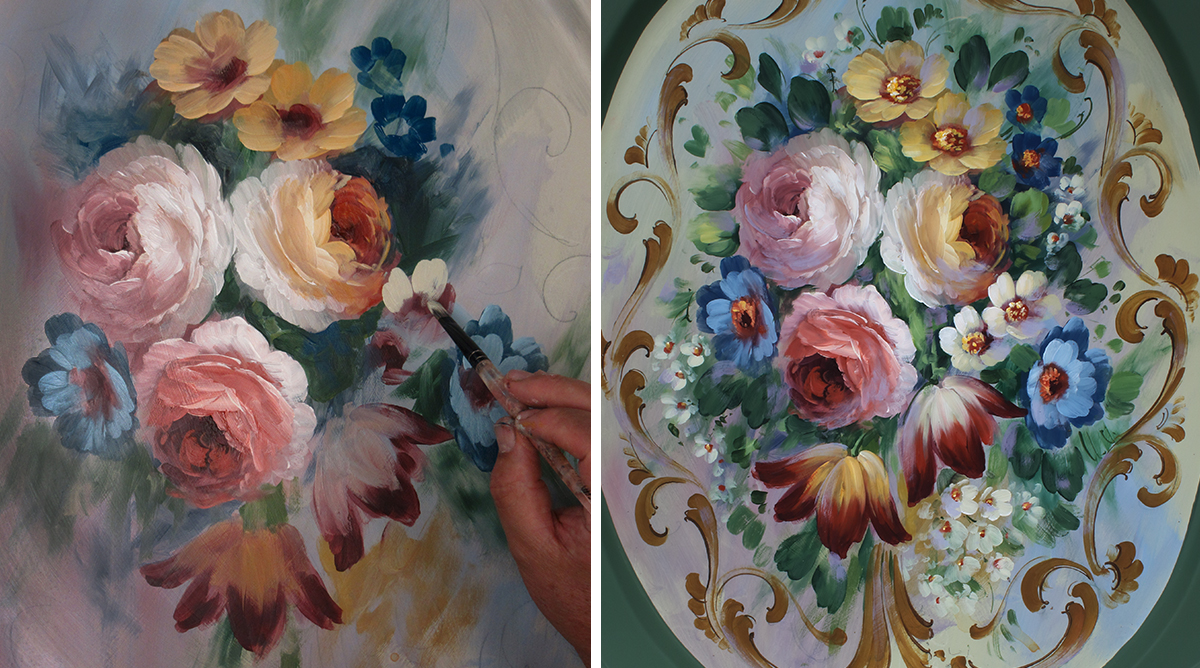
OK… This is a long one, I really hope all my artist friends grab a cuppa of strong coffee and take the time to read these morning thoughts 🙂 Back in 1983 I painted my first Valdres Rosemaling piece. I had been Rosemaling with many great teachers since 1975. Valdres though, I didn’t want to paint because it had flowers. Now, of course it is one of my favorite styles. Why? Flowers. LOL.
This month we are releasing 3 new volumes to our Rosemaling inspiration series of books showing some inspired designs and new ways of doing things. I write all the time about “change” and how it not only fuels creativity, but also attracts new people to the market. I remember for years and years going to conventions and all the exhibitors would put up signs “NEW”…”NEW” then the customers would come to the show floor and ask “What is NEW”.
One very difficult subject to talk to Rosemalers about is old vs. new. I understand that. One would think that Rosemaling is “traditional”, but when you look closely at its history, you see each style “changed” from artist to artist and through each design period. Why was Rosemaling so popular in the 1980’s and 1990’s then faded away? It was new to many people. Why did decorative painting grow so fast and then fade away? It was new. Why did people slowly lose interest in most forms of decorative painting and Rosemaling? I always come back to the same answer my teachers warned me about. Change.
Early Rosemalers were always updating their styles to what was popular at the time. Today, we can look back and clearly see the evolution of the designs. For example, Ole Halstensen Sjoli updated the Osterdalen style through the Rococo, Louis XVI and Empire periods. He created many variations of Osterdalen. After his death in 1827, the style all but disappeared. Fresh ideas and creativity are necessary to keep painting styles alive. When the creators of a style passes, the style loses momentum unless there are powerful students and successors to carry on.
Designs and styles move from one extreme to the other. For example, the fluid, fanciful style of the Rococo and Louis XVI era was followed by the strict lines of the Empire and Regency. Styles reversed again during the Impressionist movement of the later 19th century. So what was popular in one era, the opposite style is bound to become popular again in another design period. Change!
When I started to paint in the 1970s, the styles were painted freehand, without a pattern. By the time bottle acrylics arrived in the middle 1980s, the styles had become more precise, mechanical and symmetrical. Perfect side loads and detailed line work were considered the mark of a professional, especially in the American Rogaland style. The styles had changed from freehand, to patterns and mechanics. I studied and perfected my mechanics, concentrating on stroke blending and perfect lines. Then the trend changed in the early 2000s and the decorative painting market started to collapse. It started to collapse because we didn’t change with the trend. The trend was returning back to “freehand” art. People change and art needs to change too. Why does “plein air” become more popular? THOUSANDS go to those conventions each year and the decorative painting industry has collapsed. Why, Fun…. Grab some paint, a couple brushes and go paint something. You don’t need to take the time to basecoat and put on a pattern.
With this in mind, I began to relax the lines in Rosemaling. I created “casual” styles of painting. I switched from stiff synthetic brushes to the softer fusion brushes. These synthetic squirrel hair brushes do not allow precise strokes. Squirrel and cow hair brushes are the earliest brushes used in Rosemaling. I returned to painting freehand and limited my palette colors. Start designs with “sketches” and not patterns. The majority of my students embraced this new method. The old structured way was no longer fun. I was returning to the free hand method of creating and allowing each artist to express their individual style. It takes practice and courage to paint freehand, but it is the key to making the style grow and change. Today, for me, the structure of the 90s has given way to more casual interpretations.
I now look at the styles of Rosemaling and see where I can advance the looks, add more artistic principles and make a change. For this Valdres piece I added some additional concepts of “fine art” such as negative painting, harmony coloring, workup tones etc. It changed the approach to painting this style and I really love it. I worked the entire painting, all flowers at the same time and not one flower at a time. Not, basecoat, shadow and highlight. Some of you will embrace the change and some will not. It is ok! The change is to keep it interesting. Keep it fun!!!!
To ALL my artistic friends who LOVE Folk Art as I do…. Let’s all take a really good look at the history of our art. Be honest, where are the next generation of painters today? Why haven’t they embraced these time tested art forms, and made the necessary changes to attract the next generation of artist? History gives us the answers if we truly look.
Today, in art universities, there is a push on “individualism”. The students are pushed to “create their own work”. Guess what…. they don’t use patterns. Decorative painters still do. When I started Rosemaling and sat in my first Telemark class in 1975, there was not a pattern. Just an idea, a style, a concept and a starting point. Let the paint flow and find the shapes. Rosemaling is PERFECT for artists today who are graduating from universities if we just return to a few principles that historical Rosemalers used when they created new styles of Rosemaling. WE GOT THIS!

 I so love to paint casual. It has been a real journey for me to make my brush casual after being a Rosemaler and stroke artist for over 20 years. Looking at new ways of doing things and breaking some habits just takes time and patience. This is a set photo from our new Rosemaling Inspired books. Here I am decorating some of the areas with additional line work. Since I am presenting the work so casually, I also need to do that to the line work as well or it will stand off the surface too much. I will usually decorate 2 or 3 areas and then go back and wipe through those areas with my finger. This keeps the line work from being too perfect when compared to the flowers. I do this for scrolls, leaves, roses to give more lost edges. In the 1980’s I so love the perfect mechanical edges of a scroll. Over time, I have grown to love the casual nature. History has shown the huge swings in design decoration. The casual free flowing nature of Louis XVI painting lead the way to the structure of the Empire design period, which lead to the very causal impressionist. It seems this is the natural progression of the artist and arts. We love to explore all looks and try new things. I do! 🙂
I so love to paint casual. It has been a real journey for me to make my brush casual after being a Rosemaler and stroke artist for over 20 years. Looking at new ways of doing things and breaking some habits just takes time and patience. This is a set photo from our new Rosemaling Inspired books. Here I am decorating some of the areas with additional line work. Since I am presenting the work so casually, I also need to do that to the line work as well or it will stand off the surface too much. I will usually decorate 2 or 3 areas and then go back and wipe through those areas with my finger. This keeps the line work from being too perfect when compared to the flowers. I do this for scrolls, leaves, roses to give more lost edges. In the 1980’s I so love the perfect mechanical edges of a scroll. Over time, I have grown to love the casual nature. History has shown the huge swings in design decoration. The casual free flowing nature of Louis XVI painting lead the way to the structure of the Empire design period, which lead to the very causal impressionist. It seems this is the natural progression of the artist and arts. We love to explore all looks and try new things. I do! 🙂 While writing the new Telemark Inspiration book the other day I thought it would be great to share just a few thoughts with those that might want to try something new. With this lesson from the book I talk about painting lost edges…. really lost edges.. 🙂 You can see in the photo on the right and bottom below the rose. This gives new looks, which is important for the growth and popularity of any style of painting. While I was writing however, I also discuss just how important it is for color movement. Don’t forget that, especially in Rosemaling inspired designs. With Rosemaling, the power of the movement comes from the beautiful scrolls. That must always be respected in the design. When I painted these roses right in the middle, I disrupt that movement which adds some form contrast, but can also create trouble for the design if you do not use color movement. How do I assist the scrolls? I take the reds (color of contrast) from the roses and move it softly through the scrolls. This simple little thing, increases the movement of the scrolls once again and also causes the viewers eye to travel through the color of the roses. WIthout the red orange strokes on the scrolls, the design would be heavy in the center with the color contrast.
While writing the new Telemark Inspiration book the other day I thought it would be great to share just a few thoughts with those that might want to try something new. With this lesson from the book I talk about painting lost edges…. really lost edges.. 🙂 You can see in the photo on the right and bottom below the rose. This gives new looks, which is important for the growth and popularity of any style of painting. While I was writing however, I also discuss just how important it is for color movement. Don’t forget that, especially in Rosemaling inspired designs. With Rosemaling, the power of the movement comes from the beautiful scrolls. That must always be respected in the design. When I painted these roses right in the middle, I disrupt that movement which adds some form contrast, but can also create trouble for the design if you do not use color movement. How do I assist the scrolls? I take the reds (color of contrast) from the roses and move it softly through the scrolls. This simple little thing, increases the movement of the scrolls once again and also causes the viewers eye to travel through the color of the roses. WIthout the red orange strokes on the scrolls, the design would be heavy in the center with the color contrast.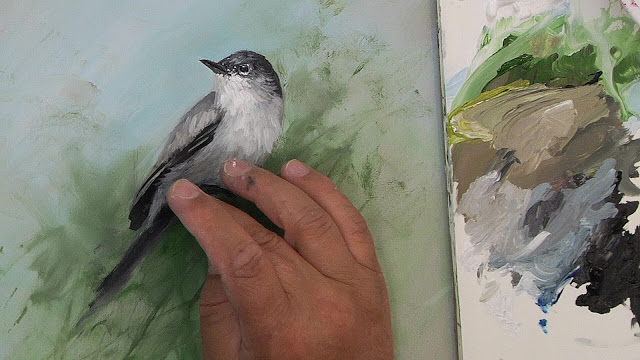
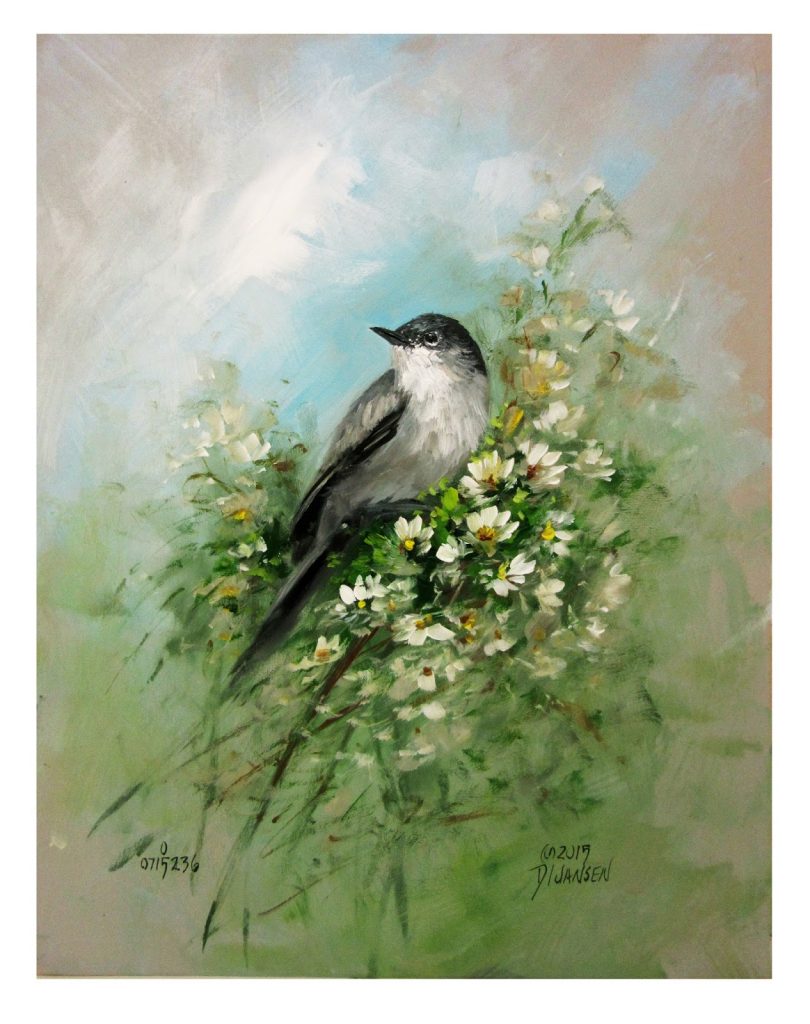 Lost edges are soft edges and are so very important in creating the mood of the painting. As you develop your style and look to your paintings always remember that lost edges create the mood. Notice in the photo above how the face and head of the bird “jump” off the background. This is because those areas are well defined. Outer areas and colors are lost. This helps define the story of my painting making the head of the bird the subject. Find a subject, then make a story around that subject. Create your art!
Lost edges are soft edges and are so very important in creating the mood of the painting. As you develop your style and look to your paintings always remember that lost edges create the mood. Notice in the photo above how the face and head of the bird “jump” off the background. This is because those areas are well defined. Outer areas and colors are lost. This helps define the story of my painting making the head of the bird the subject. Find a subject, then make a story around that subject. Create your art! The look of your painting is controlled by various factors. One very important one is the brush and its size. While many artists run to use many brushes, for most of my paintings I will use 2 or 3. This gives wonderful harmony to the techniques. Painting a large rose for example with a small brush will give lots of stroke movement. Using that same brush to paint flowing scrolls will give that same movement and thus harmony in technique. Changing to different brushes within the painting can make objects appear disjointed. While we may desired many brushes in a landscape to show different objects and textures, it is not always wise in other genre. How many brushes and brush types you use can give more interest, and in many cases too much interest, and it can also give harmony. The artist must balance the choice because a rose painted with a # 4 will look different than one painted with a # 10. I will try many times when painting roses and scrolls to paint them both using the same size brush so while they have contrast of color and form, they have consistency in technique giving harmony to the painting.
The look of your painting is controlled by various factors. One very important one is the brush and its size. While many artists run to use many brushes, for most of my paintings I will use 2 or 3. This gives wonderful harmony to the techniques. Painting a large rose for example with a small brush will give lots of stroke movement. Using that same brush to paint flowing scrolls will give that same movement and thus harmony in technique. Changing to different brushes within the painting can make objects appear disjointed. While we may desired many brushes in a landscape to show different objects and textures, it is not always wise in other genre. How many brushes and brush types you use can give more interest, and in many cases too much interest, and it can also give harmony. The artist must balance the choice because a rose painted with a # 4 will look different than one painted with a # 10. I will try many times when painting roses and scrolls to paint them both using the same size brush so while they have contrast of color and form, they have consistency in technique giving harmony to the painting.




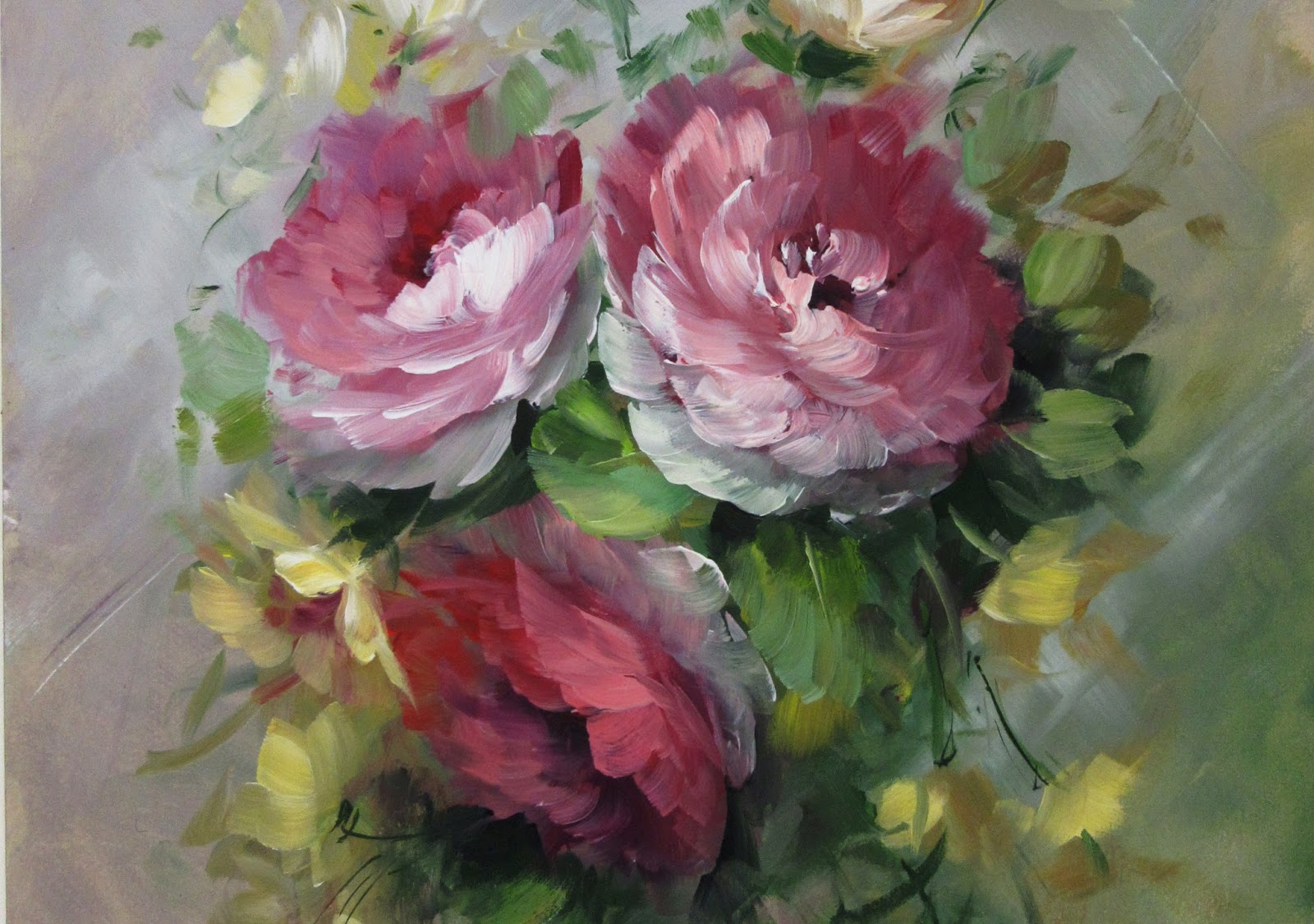
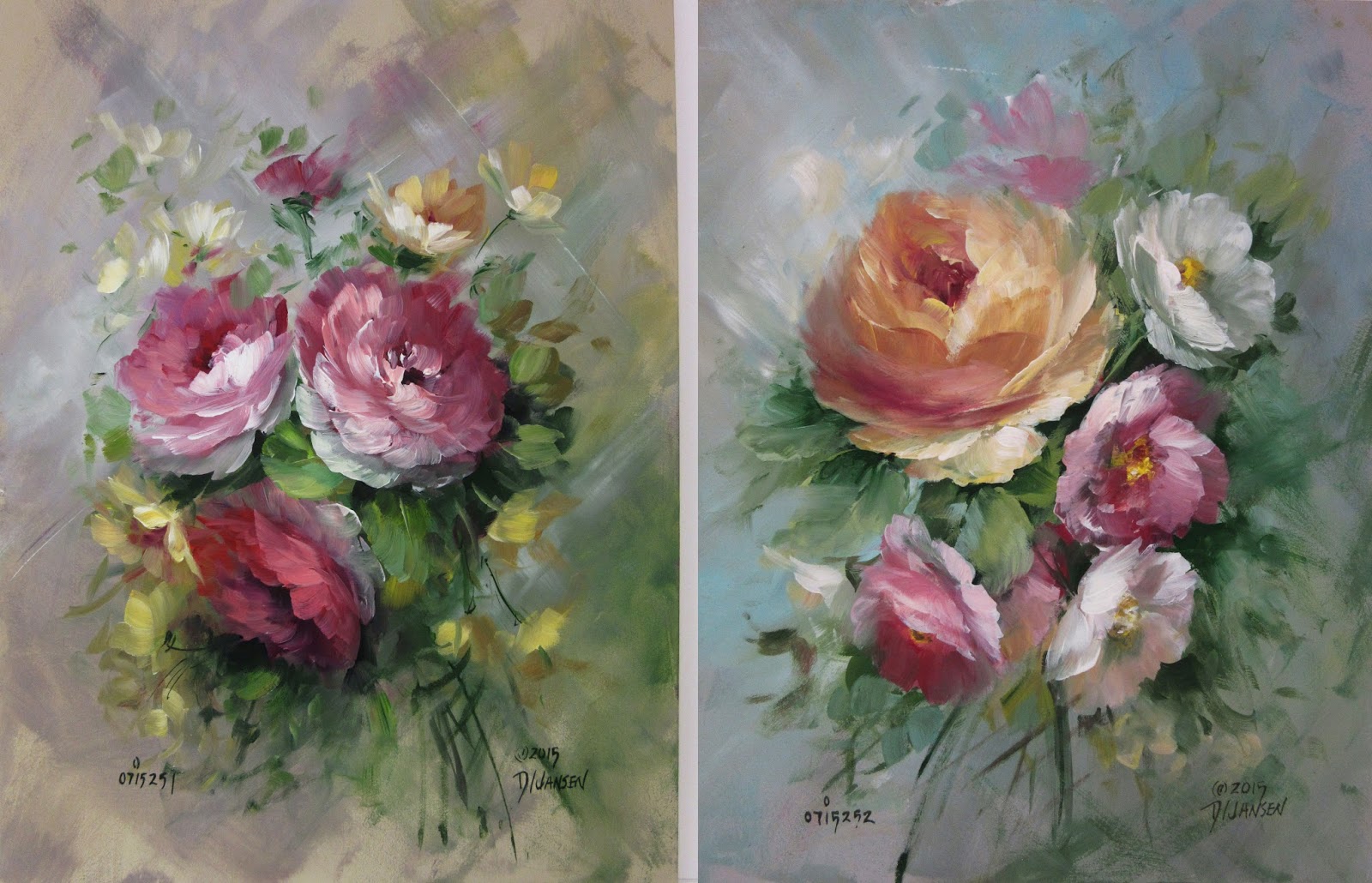 Painting with your hand and then the brush is a teaching and learning method. It works! This past few years I have used volume, speed and accuracy to teach new methods to paint. Repetitive painting (volume) teaches you direction. If you understand where you are going you will paint it better. You paint better when you know what is coming next. Speed keeps you from playing. If you are like me, you will play and play with the flowers until they all look the same. Give yourself 30 minutes to paint a group of flowers and you have to move! No time to make if perfect and guess what, it will have more life and energy.
Painting with your hand and then the brush is a teaching and learning method. It works! This past few years I have used volume, speed and accuracy to teach new methods to paint. Repetitive painting (volume) teaches you direction. If you understand where you are going you will paint it better. You paint better when you know what is coming next. Speed keeps you from playing. If you are like me, you will play and play with the flowers until they all look the same. Give yourself 30 minutes to paint a group of flowers and you have to move! No time to make if perfect and guess what, it will have more life and energy.



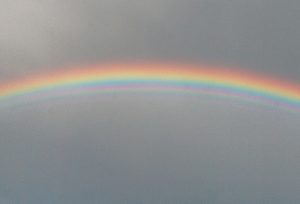
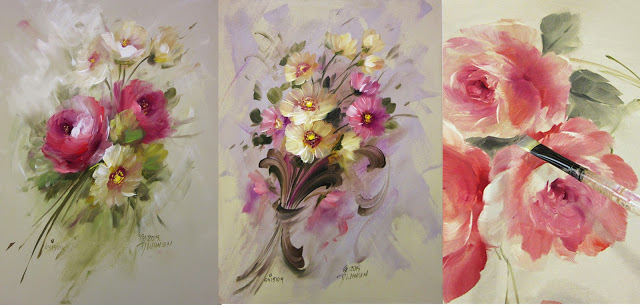 I really enjoy painting all things, all styles. For years and years I wanted to be able to paint beautiful flowers. Lots of them. I studied history, artists, techniques to learn new ways. This was great, but it still didn’t help with me create my look to flowers. I painted for 20 years searching for that direction.
I really enjoy painting all things, all styles. For years and years I wanted to be able to paint beautiful flowers. Lots of them. I studied history, artists, techniques to learn new ways. This was great, but it still didn’t help with me create my look to flowers. I painted for 20 years searching for that direction.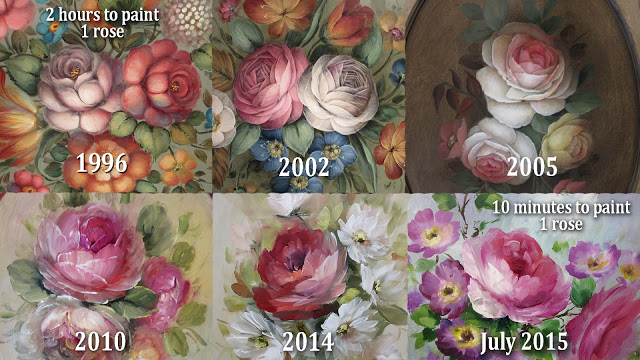
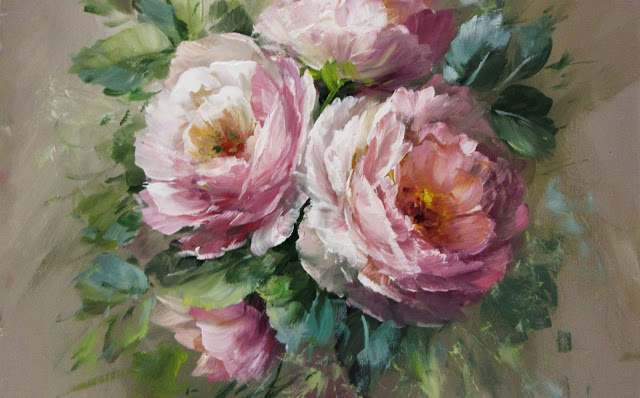 Each style I painted teaches me something different that I then take into other styles. For example, I learn about holding my brush very flat and scrapping the surface to paint clouds in landscapes. I take that techniques into my roses to give them different looks. Today, I use my hand and brush in so many ways. The brush is just a tool for applying paint. I began using it only for strokes and my paintings were stiff and mechanical. Holding the brush in different ways, using your fingers, pushing the brush just as much as pulling the brush gives your painting more energy and life. I love it.
Each style I painted teaches me something different that I then take into other styles. For example, I learn about holding my brush very flat and scrapping the surface to paint clouds in landscapes. I take that techniques into my roses to give them different looks. Today, I use my hand and brush in so many ways. The brush is just a tool for applying paint. I began using it only for strokes and my paintings were stiff and mechanical. Holding the brush in different ways, using your fingers, pushing the brush just as much as pulling the brush gives your painting more energy and life. I love it.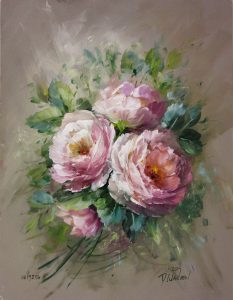 When I first introduced these technique to my classes 6 years ago, so many had trouble with it. It really showed the habits we have as artists. Many times I will walk around the class and see everyone holding the brush in the same position throughout the painting. Everyone will use a different size brush, but then apply the paint with the same strokes. Painting beautiful objects is all about the movement of the color. Waves, leaves, petals and clouds. Movement. Using the same strokes to capture that movement makes all of the objects have the same look and thus less interest to your painting. Of course everything will look the same because you painted it the same. Add life and energy to your paintings by not only varying the colors, but vary how you apply those colors. Look at each object independent of the others and vary how you apply the color passages to render the shapes. That is the key to making beautiful paintings.
When I first introduced these technique to my classes 6 years ago, so many had trouble with it. It really showed the habits we have as artists. Many times I will walk around the class and see everyone holding the brush in the same position throughout the painting. Everyone will use a different size brush, but then apply the paint with the same strokes. Painting beautiful objects is all about the movement of the color. Waves, leaves, petals and clouds. Movement. Using the same strokes to capture that movement makes all of the objects have the same look and thus less interest to your painting. Of course everything will look the same because you painted it the same. Add life and energy to your paintings by not only varying the colors, but vary how you apply those colors. Look at each object independent of the others and vary how you apply the color passages to render the shapes. That is the key to making beautiful paintings.
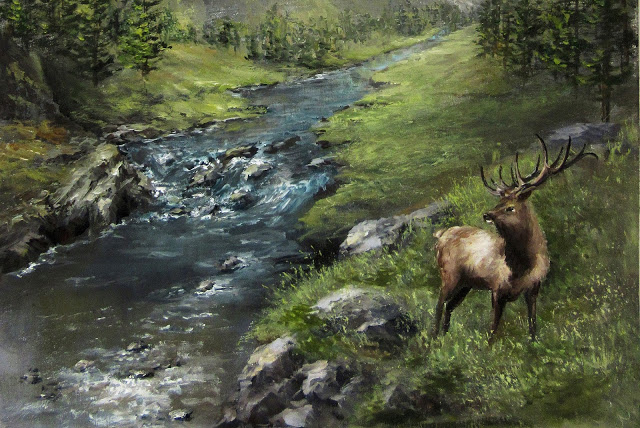 One question I have from my students all the time is how to paint things. How do I decide? Well, I am a professional artist. It is funny because most people think you can’t make a living as an artist. Well, they are wrong… really, really wrong, but you must do it correctly and professionally. You must follow the trends and diversify. You must constantly change.
One question I have from my students all the time is how to paint things. How do I decide? Well, I am a professional artist. It is funny because most people think you can’t make a living as an artist. Well, they are wrong… really, really wrong, but you must do it correctly and professionally. You must follow the trends and diversify. You must constantly change.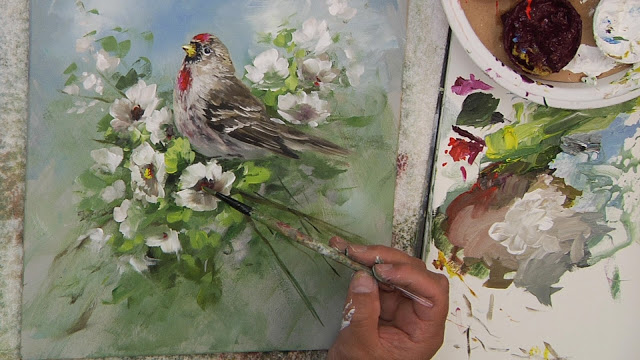 For many years in decorative painting I have struggled to find ways as an artist to add interest to my paintings. Interest can come in many ways. Rosemalers use the power and movement of the acanthus scroll. Your eye follows the line of the design and thus you find that line of movement “interesting”. In recent years as I added more painting genres I have added new ways to create interest in my work. Studying the floral impressionists of the 19th century introduced the power of the lost and found edge, movement through the design through visual differences in the objects. This became my favorite way to paint for the past few years. I present paintings for my students and customers that take your eye on a visual journey through colors, form, and edges. The redpoll above is an example of this type of movement. The flowers in the center show more definition than flowers on the outside. How much detail and how “real” you paint the redpoll also adds this visual interest. Reducing the edges, softening the effect pushes objects back and thus creates a visual journey for your eye and interest.
For many years in decorative painting I have struggled to find ways as an artist to add interest to my paintings. Interest can come in many ways. Rosemalers use the power and movement of the acanthus scroll. Your eye follows the line of the design and thus you find that line of movement “interesting”. In recent years as I added more painting genres I have added new ways to create interest in my work. Studying the floral impressionists of the 19th century introduced the power of the lost and found edge, movement through the design through visual differences in the objects. This became my favorite way to paint for the past few years. I present paintings for my students and customers that take your eye on a visual journey through colors, form, and edges. The redpoll above is an example of this type of movement. The flowers in the center show more definition than flowers on the outside. How much detail and how “real” you paint the redpoll also adds this visual interest. Reducing the edges, softening the effect pushes objects back and thus creates a visual journey for your eye and interest.

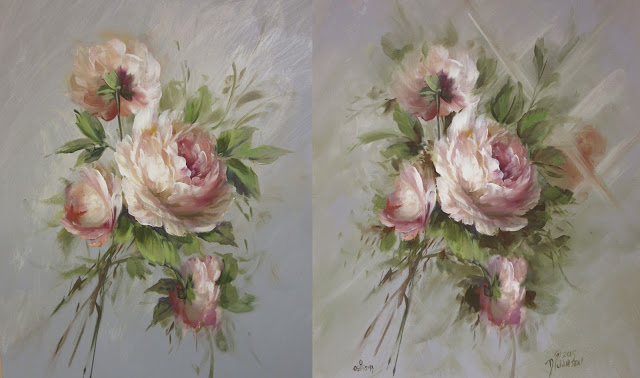

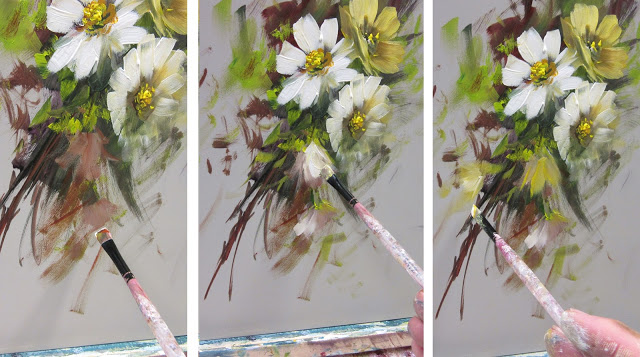 When I first started painting years ago, I was so afraid of making a mistake. I carefully tried to copy each color my teacher showed me. Now, years later, I realize that I could have relaxed a bit and I probably wouldn’t have become prematurely grey if I had done just that.
When I first started painting years ago, I was so afraid of making a mistake. I carefully tried to copy each color my teacher showed me. Now, years later, I realize that I could have relaxed a bit and I probably wouldn’t have become prematurely grey if I had done just that.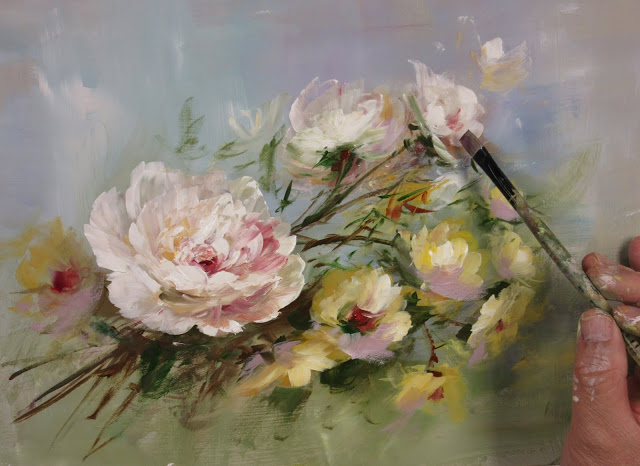 Paintings are beautiful because they connect to the viewer in some way. I use a variety of techniques to make those connections. I am a pure technique painter. I am not talented like some say, I use techniques. Learned processes that anyone can use with the proper amount of practice and education. It takes time, it take practice. One technique I learned and practice this last year was an edging technique. It uses an older brush in many new ways. For this painting I use a variety of edges. Some flowers have soft and lost edges while the stems use this new edging technique where I use the corner of the brush and push away. I also use the corner of the brush to add those details in the centers of the flowers. The contrast between the edgy stems and the softer flowers gives the different look I was looking for in the painting. As I have said many times, artists are painters of edges. Just where and how you place and use those edges gives you a variety of looks. You can have a variety of colors in the background, but you need to keep the edges soft so the color recede against the flowers. The more edges the flowers have, the more edges the background can have, but overall it is a relationship of edges that makes the painting work. I have found this last year that if I increase the edges in the stems, especially in the center of interest, I can place more color in the background. Many people email me and say they love my backgrounds. I do too….now…. It has been a road of trial and error to get the backgrounds to work with the painting elements. To give the background visual interest without distracting from the flowers. This is where the wonder stems come into play. Using the corner of the brush to capture some casual stems, with lots of edges, lifts the flowers off the background. Edges advance. They also contrast the flowers and give me the correct amount of visual interest I was looking for in this painting. Are they perfect stems? No…. then are fractured to create interest but also break the lines so they cause your eye to move on to other elements. How did I know to do this? Technique… Painting the stems with the corner of an old brush instead of the point of a round or liner. I learned a new way.
Paintings are beautiful because they connect to the viewer in some way. I use a variety of techniques to make those connections. I am a pure technique painter. I am not talented like some say, I use techniques. Learned processes that anyone can use with the proper amount of practice and education. It takes time, it take practice. One technique I learned and practice this last year was an edging technique. It uses an older brush in many new ways. For this painting I use a variety of edges. Some flowers have soft and lost edges while the stems use this new edging technique where I use the corner of the brush and push away. I also use the corner of the brush to add those details in the centers of the flowers. The contrast between the edgy stems and the softer flowers gives the different look I was looking for in the painting. As I have said many times, artists are painters of edges. Just where and how you place and use those edges gives you a variety of looks. You can have a variety of colors in the background, but you need to keep the edges soft so the color recede against the flowers. The more edges the flowers have, the more edges the background can have, but overall it is a relationship of edges that makes the painting work. I have found this last year that if I increase the edges in the stems, especially in the center of interest, I can place more color in the background. Many people email me and say they love my backgrounds. I do too….now…. It has been a road of trial and error to get the backgrounds to work with the painting elements. To give the background visual interest without distracting from the flowers. This is where the wonder stems come into play. Using the corner of the brush to capture some casual stems, with lots of edges, lifts the flowers off the background. Edges advance. They also contrast the flowers and give me the correct amount of visual interest I was looking for in this painting. Are they perfect stems? No…. then are fractured to create interest but also break the lines so they cause your eye to move on to other elements. How did I know to do this? Technique… Painting the stems with the corner of an old brush instead of the point of a round or liner. I learned a new way.